

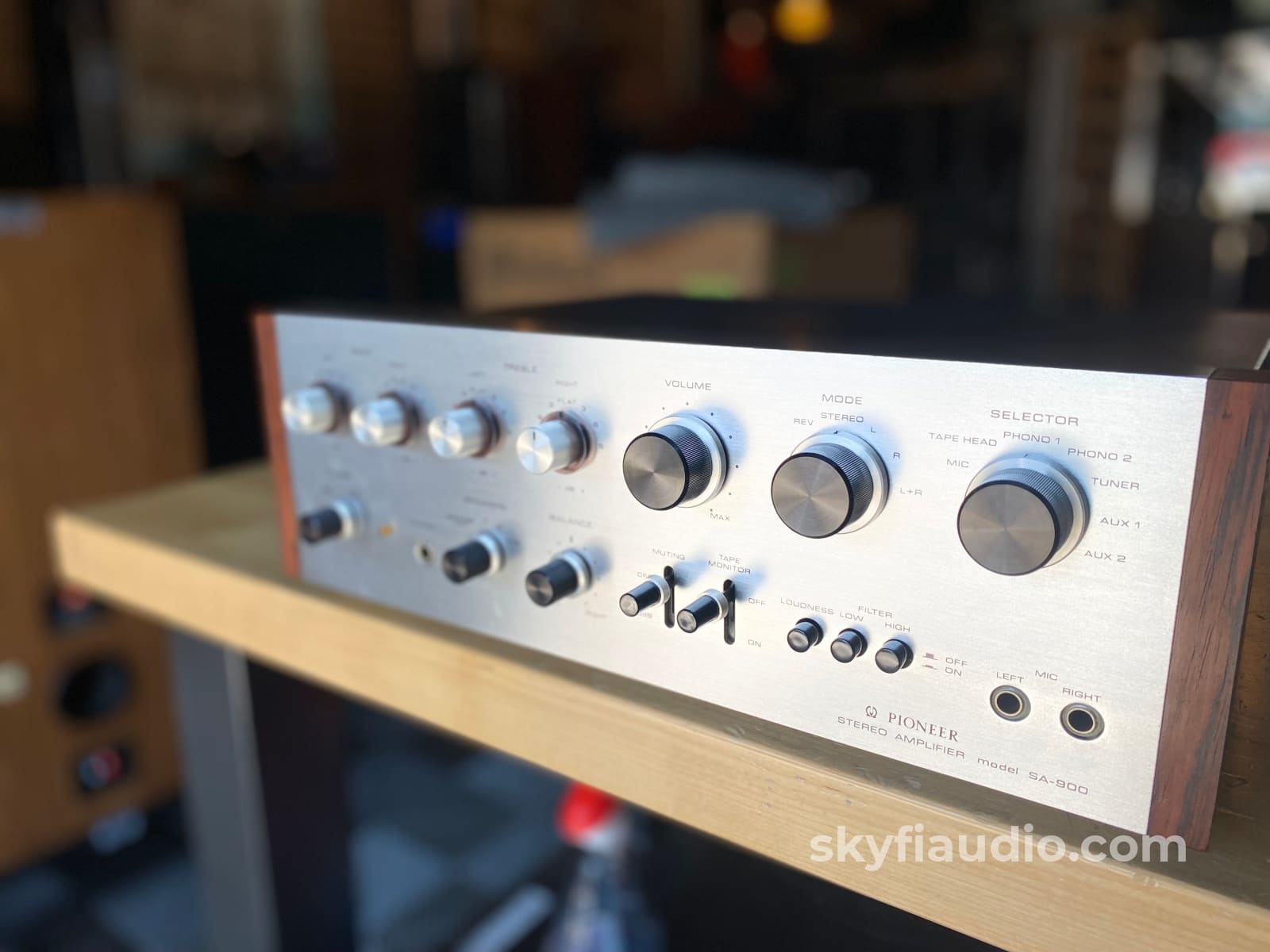

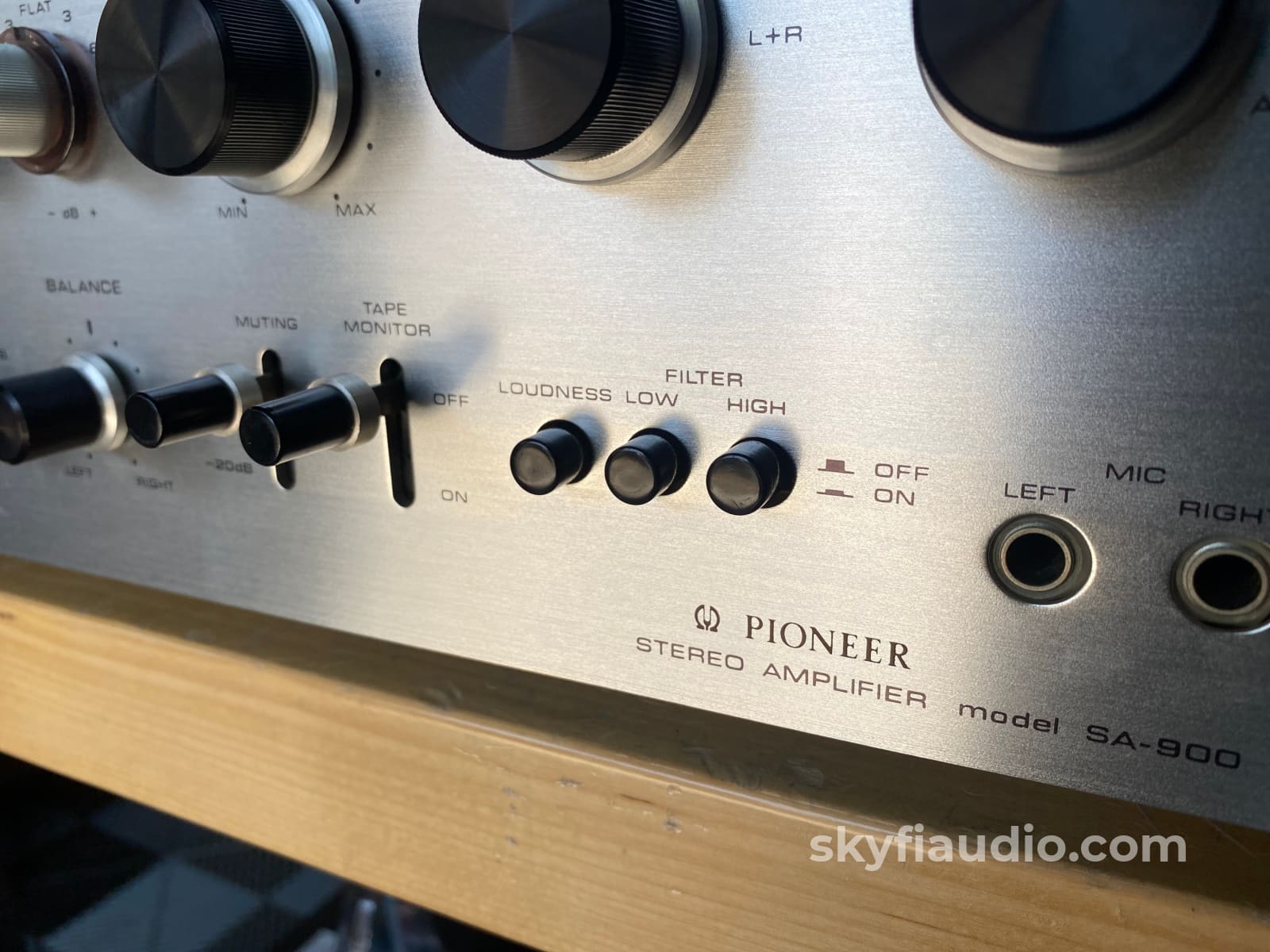
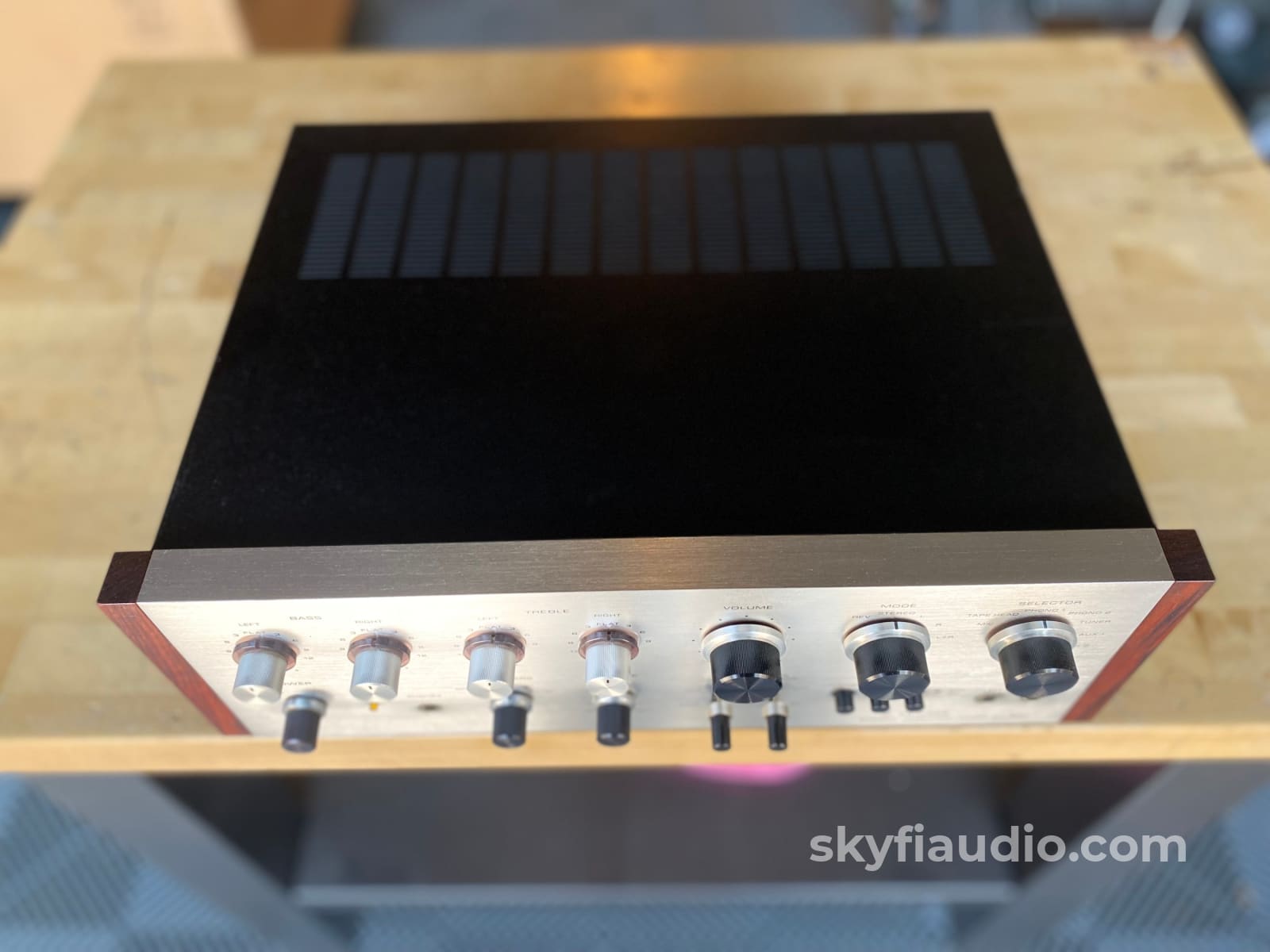


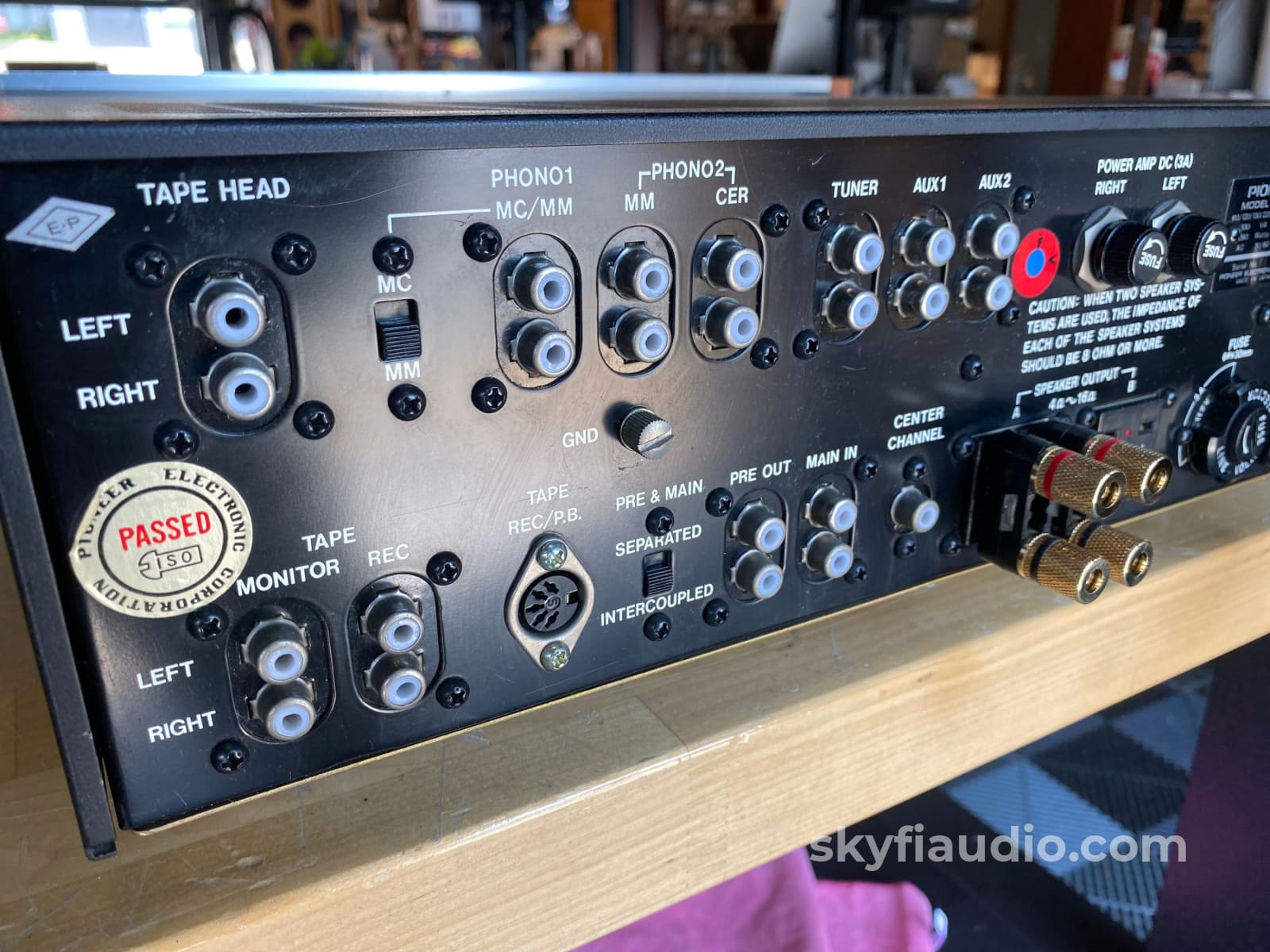

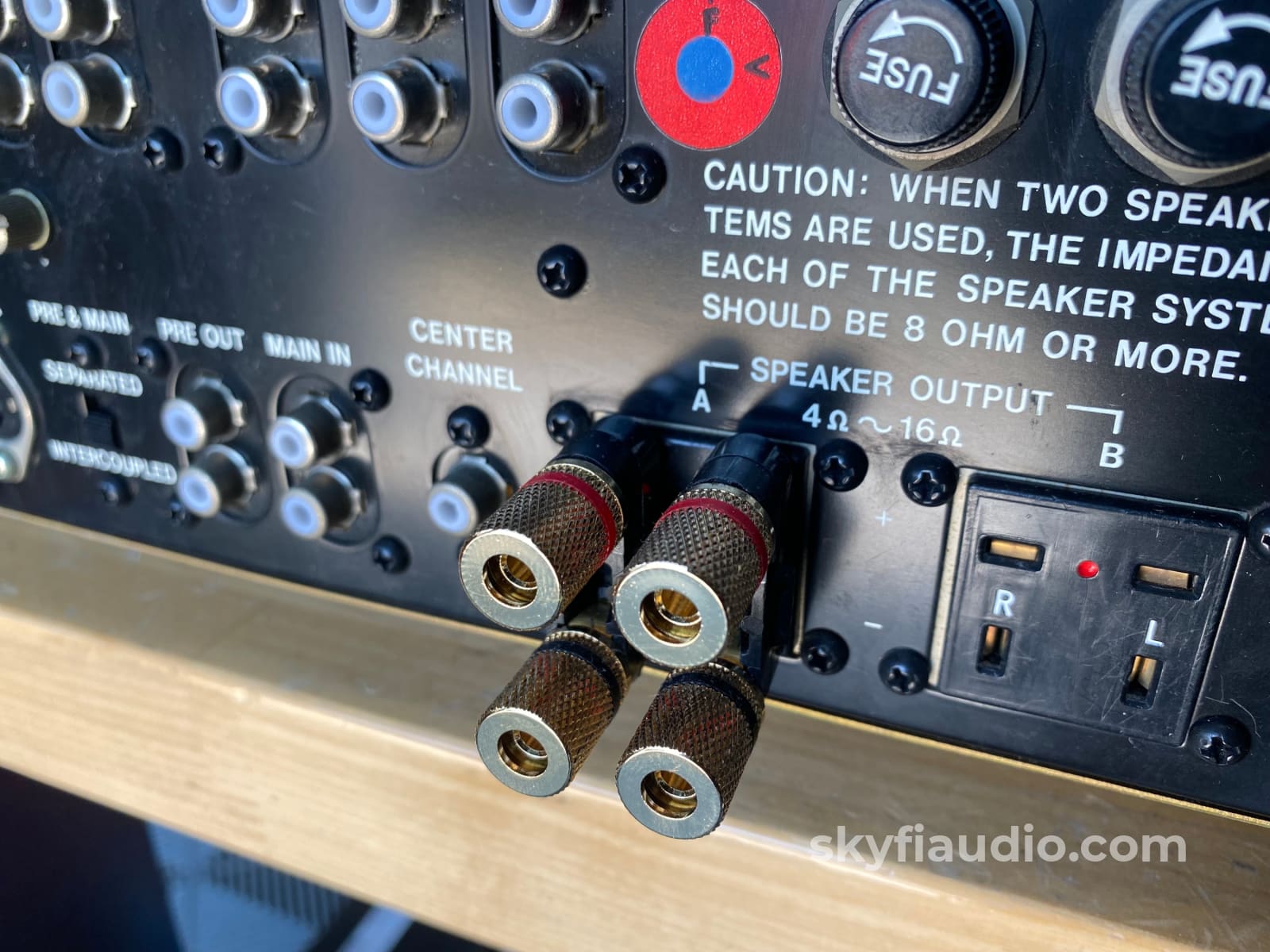
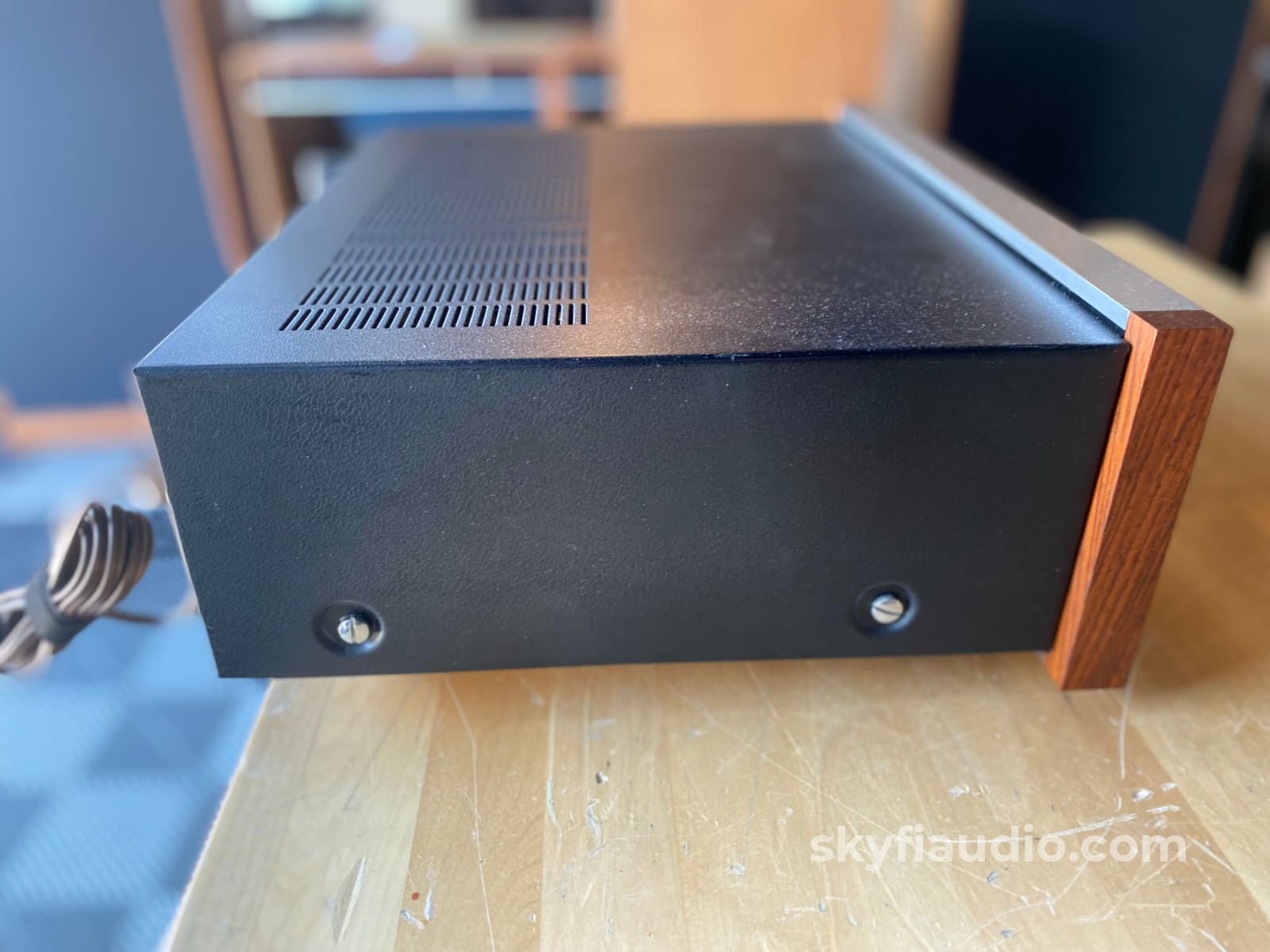


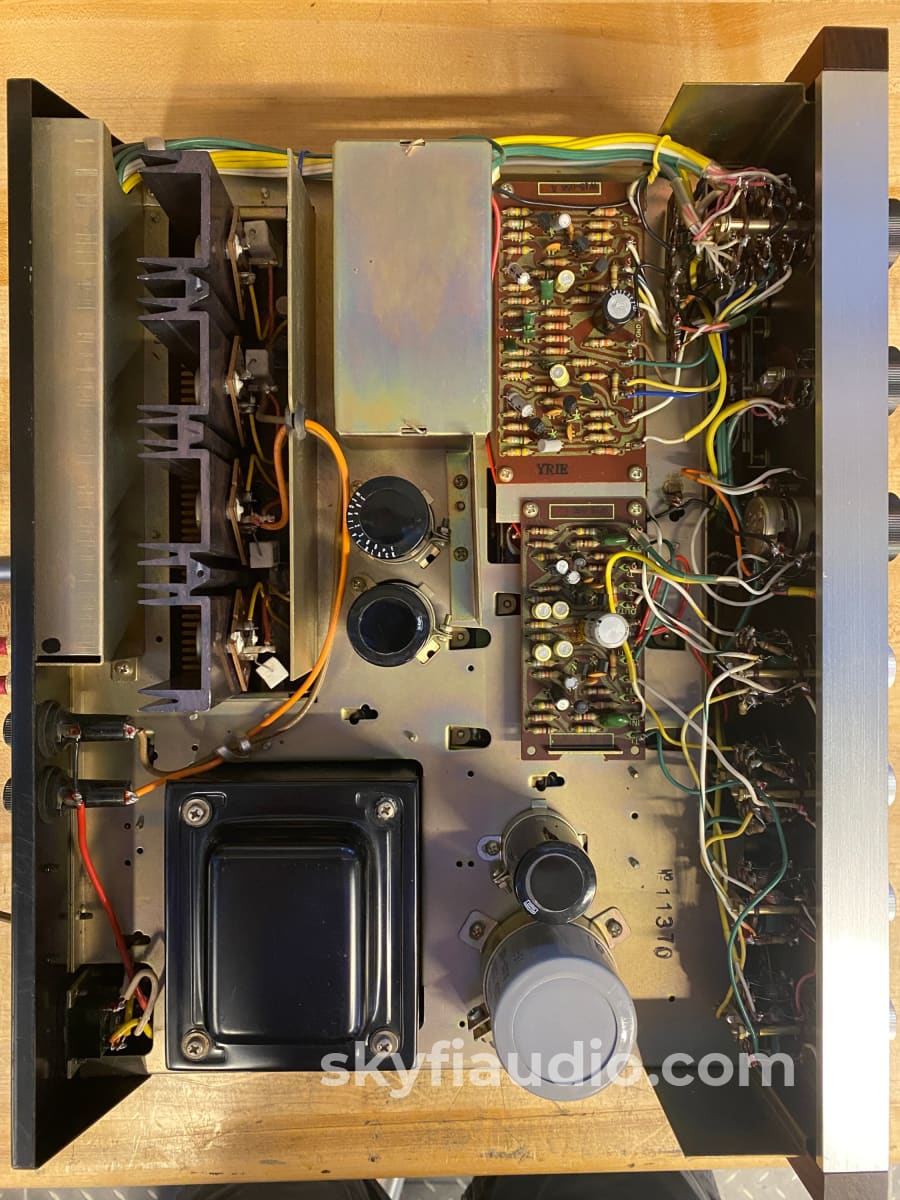

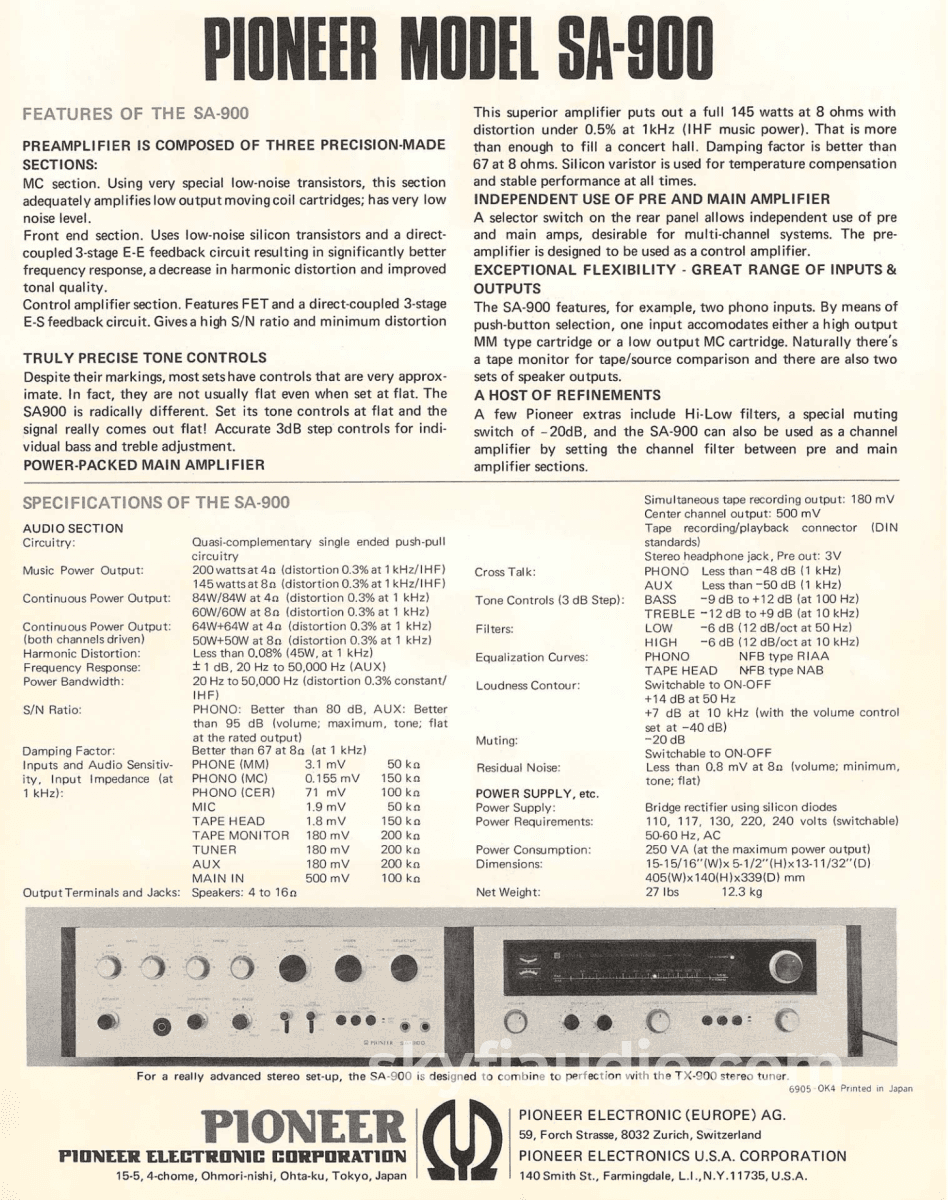
Pioneer SA-900 Integrated Amplifier
Free Shipping on Most Electronics - Excludes Speakers and Items Requiring Freight - Contiguous U.S. Only
Pickup currently unavailable at SkyFi 479

Pioneer SA-900 Integrated Amplifier
SkyFi 479
479 South Broad Street
Glen Rock NJ 07452
United States
Here we present a gorgeous vintage Pioneer integrated amp from the 1970's. The light aluminum finish against the wood side panels is a great look.
Don't be fooled by the specs, by today's measuring standards it does not produce 200 watts. Expect more like 50-60 watts which is enough to power most vintage speakers to very high levels.
This Pioneer is full of features you'd want in a vintage integrated including very capable tone controls and phono inputs.
SkyFi Notes:
• These Pioneer era HiFi pieces are fitted with proprietary speaker connectors which are very inconvenient. We have opted to install a single set of reproduction connectors which offer a convenient banana connection.
• Light blemishes on faceplate and metal cover (See Images).
• Tested to power and working properly.
Recommended Cables:
Kimber Kable - RCA Interconnects - Better
Kimber Kable - RCA Interconnects - Best
Kimber Kable - Phono Interconnects - Better
Kimber Kable - Flagship Phono Interconnects - Best
More from Pioneer:
The SA-900 is one of Pioneer's most advanced amplifiers. It contains professional features nestly compacted into an all solid state set that's ideal for use with high performance stereo systems. It presents a powerful 200 watt integrated amplifier of exceptional flexibility.
Only the finest and most expensive materials have been used throughout, from the low noise silicon transistors in the MC and front end sections to the special Brazilian rosewood tipping the front panel. The control amplifier has FET end advanced 3-stage E-S (Emitter-Source) feedback circuitry.
The pre and main amplifiers can be used independently and there are inputs for a wide variety of cartridges and 2 sets of speaker terminals.
Features
Preamplifier is composed of three precision made sections.
MC Section: using very special low-noise transistors, this section adequately amplifies low output moving coil cartridges. Has very low noise level.
Front-end Section: uses low-noise silicon transistors and a direct coupled 3-stage E-E feedback circuit, resulting in significantly better frequency response, a decrease in harmonic distorion and improved tonal quality.
Control Amplifier Section: features FET and a direct-couples 3-stages E-S feedback circuit. Gives a high S/N ratio, and minimal distortion.
Truly Precise Tone Controls
Despite their markings, most sets have controls that are very approximate. In fact, they are not usually flat even when set at flat. The SA-900 is radically different. Set its tone controls at flat, and the signal really comes out flat. Accurate 3 dB step controls for individual bass and treble adjustment.
Power-Packed main Amplifier
This superior main amplifier puts out a full 145 watts at 8 ohms with distortion under 0,5% (IHF music power). That is more than enough to fill a concert hall. Damping factor is better than 67 at 8 ohms. Silicon varistor is used for temperature compensation and stable performance at all times.
Independent use of Pre and Main Amplifier
A selector switch on the rear panel allows independent use of pre and main amps, desirable for multi-channel systems. The preamplifier is designed to be used as a control amplifier.
Exceptional Flexibility - unusual Range of Inputs and Outputs
The SA-900 features, for example, two phono inputs. By means of push-button selection, one input accomodates either a high output MM type cartridge or a low output MC cartridge. Naturally there's tape monitor for Tape/Source comparsion, and there are also two sets of speaker outputs.
A Host of Audio Refinements
A few Pioneer extras include Hi and Low filters, and a special muting switch of -20 dB. And the SA-900 can also be used as a channel amplifier by setting the channel filter between pre and main amplifier sections.
Specifications:
Audio Section
Circuitry: Quasi-complementary single ended push-pull
Music Power Output:
200 Watts at 4 Ω (distirtion below 0,3% at 1 kHz/IHF)
145 Watts at 8 Ω (distortion below 0,3% at 1 kHz/IHF)
Continuous Power Output:
84 W / 84 W at 4 Ω (distortion below 0,3% at 1 kHz)
60 W / 60 W at 8 Ω (distortion below 0,3% at 1 kHz)
Continuous Power Output (both Channels driven)
64 W + 64 W at 4 Ω (distortion below 0,3% at 1 kHz)
50 W + 50 W at 8 Ω (distortion below 0,3% at 1 kHz)
Total Harmonic Distortion: less than 0,08% ( 45 W at 1 kHz)
Frequency Response: 20 Hz to 50 kHz ±1 dB
Power Bandwidth: 20 Hz to 50 kHz (distortion below 0,3% constant/IHF)
Signal-to-Noise Ratio:
Phono : better than 85 dB
Aux : better than 95 dB (volume, maximum, tone flat, at the rated output/IHF)
Inputs Sensitivity/Impedance (at 1 kHz)
Phono MM : 3,1 mV/ 50 k Ω
Phono MC : 0,155 mV/ 150 k Ω
Phono CER : 71 mV/ 100 k Ω
MIC : 1,9 mV /50 k Ω
Tuner : 180 mV / 200 k Ω
Tape Monitor : 180 mV / 200 k Ω
Tape head : 1,8 mV / 150 k Ω
Aux : 180 mV / 200 k Ω
Main-In : 500 mV / 100 k Ω
Damping Factor: better than 67 at 8 Ω (at 1 kHz)
Output Terminals and Jacks
Speakers : 4 to 16 Ω
Stereo Headphones Jack, Pre-Out : 3 V
Simultaneous Tape Recording : 180 mV
Tape Recording/playback Jack : DIN standard
Center Channel Output : 500 mV
Equalization Curves:
Phono ; NFB type RIAA,
Tape : NFB type NAB
Tone Controls (3 dB step)
Bass : -9 dB to +12 dB at 100 Hz
Treble : -12 dB to +9 dB at 10 kHz
Filters:
Low : -6 dB ( 12 dB/oct) at 50 Hz
High : -6 dB (12 dB/oct) at 10 kHz
Loudness Contour: Switchable to On-Off
+14 dB at 50 Hz
+7 dB at 10 kHz
Residual Noise: less than 0,8 mV at 8 Ω (volume, mninmum, tone flat)
Muting : -20 dB (switchable On/Off)
Crosstalk (1 kHz):
Aux : less than -50 dB
Phono : less than -48 dB
Power Supply: Bridge rectifier using silicon diodes
Power Requirements: 110, 117, 130, 220, 240 Volts (switchable) 50/60 Hz AC
Power Consumption: 250 VA (max)
Dimensions (W x H x D): 405 x 140 x 339 mm (1-15/16" x 5-1/2" x 13-11/32")
Weight (Net): 12,3 kg (27 lbs)
Manual:
Original Sales Brochure:
The SkyFi Testing Process for Preamplifiers:
We start with a visual inspection of all internal components to make sure that there are no signs of heat stress or damage. Capacitors are checked for telltale signs of predictive failure including bulging, shrunken wrappers, or physical leakage. We also inspect the PCB’s for discoloration from resistors or transistors that may have been running hot. On vintage units we often spot check select capacitors for value and ESR.
When we first power on a preamplifier we connect its RCA output to a Sencore PA81 Power Analyzer which simulates real world loading conditions and gives us an oscilloscope interface. The first order of business is checking that the volume control works smoothly throughout its entire range with acceptable channel balance. This is accomplished by feeding a 1KHz sine wave into one of the preamp’s line level inputs while monitoring the preamp’s output on an oscilloscope. We then switch to a 1KHz square wave to test the tone controls, loudness function, and filters where applicable. During this step we are watching for equal alteration of the test signal by both channels. This also helps us identify dirty controls that will need treatment. Once the basic line stage functions are verified, we test each input individually. This is especially important for devices that use relays to select their sources. If the preamp is equipped with a phono stage we test that as well. We use an inverse RIAA filter which allows us to feed a reference test signal into the phono input with the proper RIAA equalization and level. A square wave or sine sweep is used to verify that the device’s phono stage is faithfully reproducing the RIAA curve. If the preamp under test has balanced inputs and/or outputs these are tested as well.
We finish up our bench testing with a listening test with our bench amplifier and reference speakers. During this test we check for hum or hiss that may not have shown up in earlier testing. We also check that all of the tone controls and filters perform as expected. If the preamplifier has remote control functions these are also tested. Preamps with tube circuits or complicated power supply topologies are connected at our long term test rig for extended stress testing under real world conditions.
The SkyFi Testing Process for Solid State Amplifiers:
We start with a visual inspection of all internal components to make sure that there are no signs of heat stress or damage. Capacitors are checked for telltale signs of predictive failure including bulging, shrunken wrappers, or physical leakage. We also inspect the PCBs for discoloration from resistors or transistors that may have been running hot. On vintage units we often spot check select capacitors for value and ESR.
If the amplifier passes visual inspection, we move on to a controlled power on sequence using a Sencore safety analyzer to monitor current draw in real time. Once the amplifier is determined to be safe to operate, we connect it to full AC mains for function and power testing. We connect the speaker outputs of the amplifier to a Sencore PA81 Power Analyzer which acts as a dummy load, DC offset monitor, and oscilloscope interface. We start with a low level 1KHz test signal at the amplifier’s input and slowly increase its amplitude while monitoring the output on an oscilloscope for signs of noise, clipping, distortion, or improper channel balance. We continue increasing the signal level until the amplifier reaches clipping. At this point we take an output power measurement and compare it to the spec sheet of the amplifier to verify proper performance. If the device under test has both balanced and single ended inputs they are both tested at this time. We finish off the bench evaluation with a 1KHz square wave check and a 20Hz to 20KHz sine sweep to assess the amplifier’s frequency response characteristics. This battery of tests will usually reveal if the amplifier has any issues that need further attention.
Before the device leaves the bench, we perform a listening test with actual music using a variety of preferred test tracks. Our benches are outfitted with familiar monitor speakers which help us identify inconsistencies that will not always show up on our test gear. The main things that we are listening for are hum or noise with no signal present, proper center image, clicks, pops, or any other obvious undesirable audio characteristics.
If the unit passes all of these tests it is moved to our long term testing rig where we simulate real word operating conditions for 6-8 hours. This allows us to monitor the unit for signs of thermal runaway or intermittent issues that only crop up when the unit has fully come up to temperature.
|
Item |
Included |
|
Original Box |
Not Included |
|
Manual |
Not Included (Online) |
|
Remote |
Not Applicable |
|
Cables |
Yes - Power Only |
|
Physical Condition (Info Here) |
7 / 10 |
|
Working Condition |
10 / 10 |
Choose options

















